Written by: Kelly Waffle
At the Hinge Research Institute, we are intrigued with the “Great Resignation” trend—what is driving it, what is its impact, why does it continue, and what are organizations doing to minimize it? In earlier research, Navigating the Mid-Career Talent Crisis: A Report For The Professional Services, we uncovered that mid-career professionals (30- to 45-years old) were the largest employee segment leaving organizations every year. In fact, nearly 30% of them quit or switched their jobs last year. What is more astounding is that nearly a third of mid-career staff quit without having another job offer.
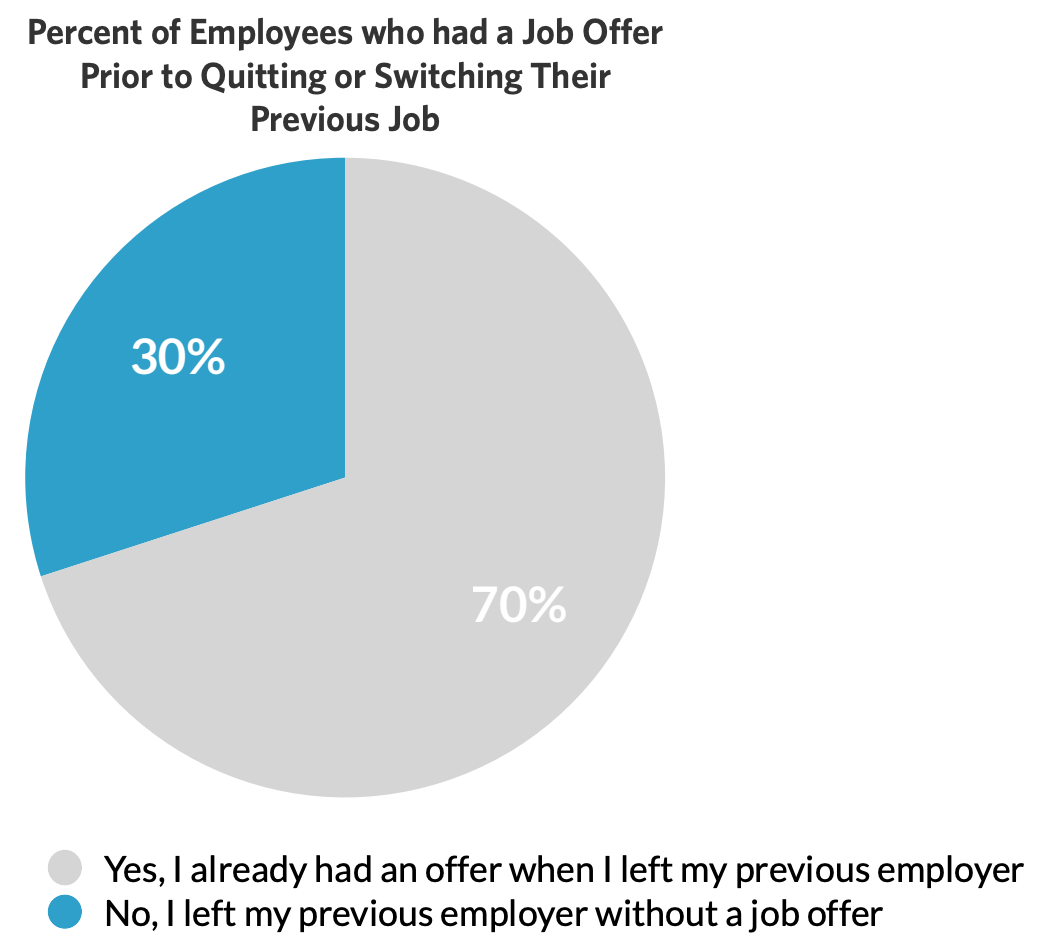
What would frustrate or motivate these mid-career employees to throw up their hands one day and say “I quit”?
I Can’t Get No Satisfaction
We surveyed 284 people in mid-career, leadership, and senior executive roles to get our answers in this new study, CULTURE CLASH: The EMPLOYEE Experience Problem And How To Fix It. As we were pulling together our findings, a couple of themes kept popping up. 1.) A fair amount of people are not satisfied with their company culture—no matter how you look at it. 2.) Mid-career professionals and senior executives often had different responses and perspectives on culture-related topics.
These two themes unveil a culture clash that is happening in companies across the globe. Many companies may not be aware of this culture clash and that these themes represent the primary drivers prompting so many resignations.
For example, take a look at this chart:

More than 48% of mid-career staff are dissatisfied with their current company culture while only 10% of senior executives are dissatisfied with their culture. That is a noticeable difference in opinion and may impact how certain culture-related decisions are made or not made. However, employee segment is only one way to look at company culture dissatisfaction. As you can see by the following chart, company size also plays a role in culture satisfaction and dissatisfaction.
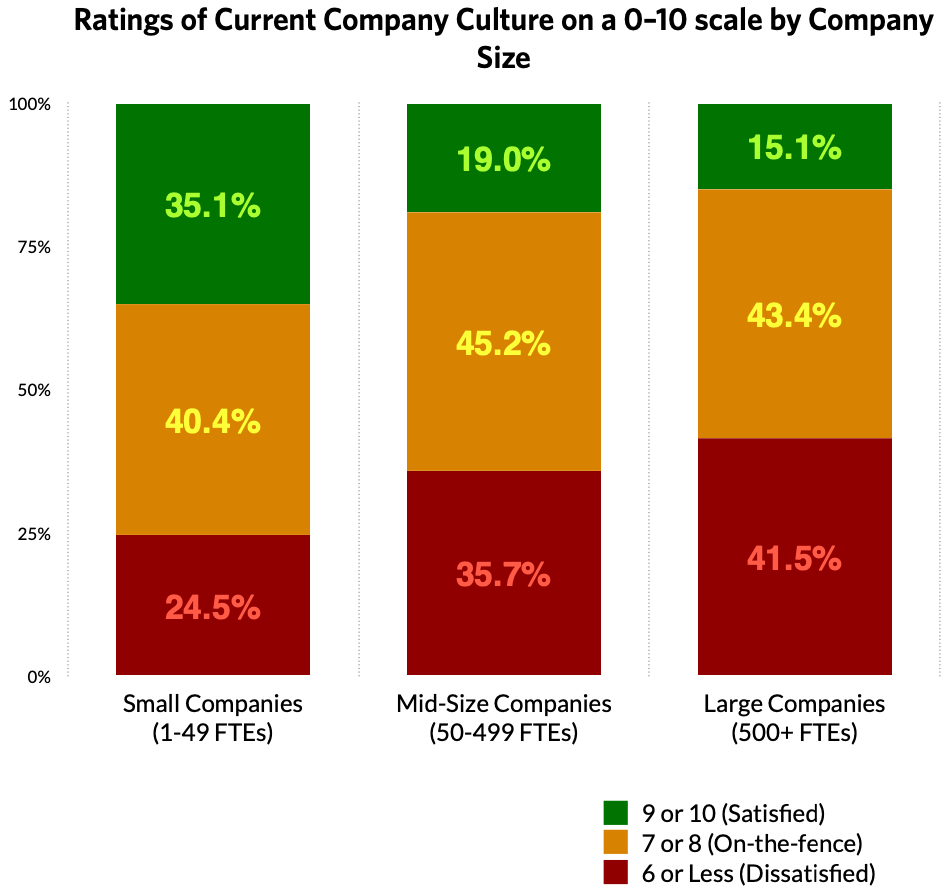
We were a little surprised that there was more culture dissatisfaction within large companies where there tend to be more employee benefits and programs in place. We found some explanation for these results later in the research, when we asked for recommendations to improve company culture.
Download the CULTURE CLASH: The EMPLOYEE Experience Problem And How To Fix It Research Study
It is also interesting to look at company culture satisfaction and dissatisfaction by industry. The only clear winner is the software and technology industry, which had the highest culture satisfaction (36%) and the lowest culture dissatisfaction (24%). Clearly, the industry that needs to focus most on company culture is architecture, which has the lowest percentage of culture satisfaction and one of the highest percentages of culture dissatisfaction. The other industries seem to have a mixed bag of responses with “On-the-fence” being a large variable condition. It will be interesting to see how these industry responses change in future research studies.

Company culture satisfaction and dissatisfaction are variables that should be measured on a regular or consistent basis. If you can address the dissatisfaction before the level starts to rise, you have a chance of affecting positive change and averting a disruptive situation. However, when dissatisfaction rises to a certain level your employees move from “Not Seeking” status to “Passively Seeking” status. Even worse, if the dissatisfaction levels continue to rise, your employees will move from “Passively Seeking” status to “Actively Seeking” status and then it is much harder to retain them. See the following chart.
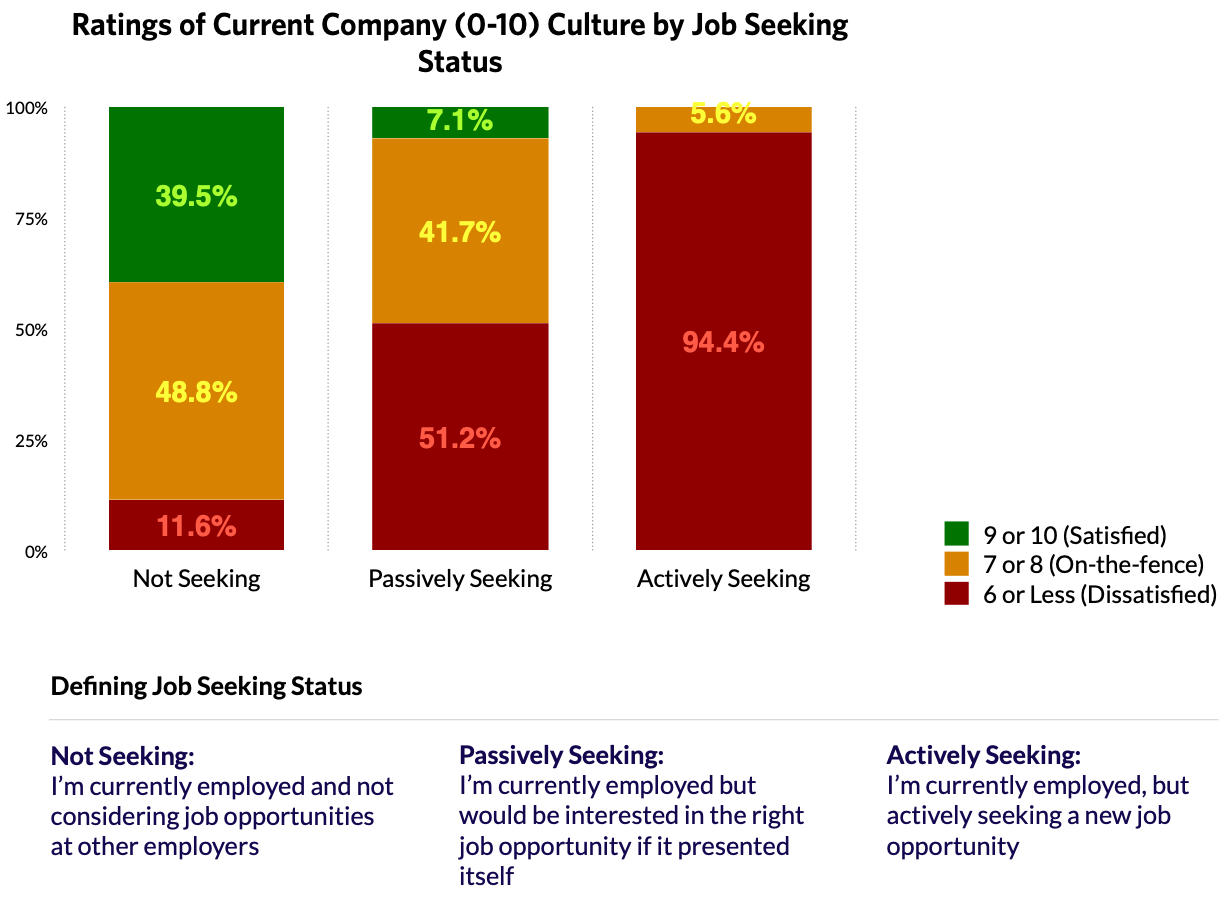
Not Seeing Eye to Eye
Wanting a better company culture is definitely a key driver of the culture clash. It is the #2 reason respondents gave for quitting their jobs in the past year (see the chart below). The #1 reason for all of those resignations in the last year was: “I was frustrated with leadership/management at my previous job.”
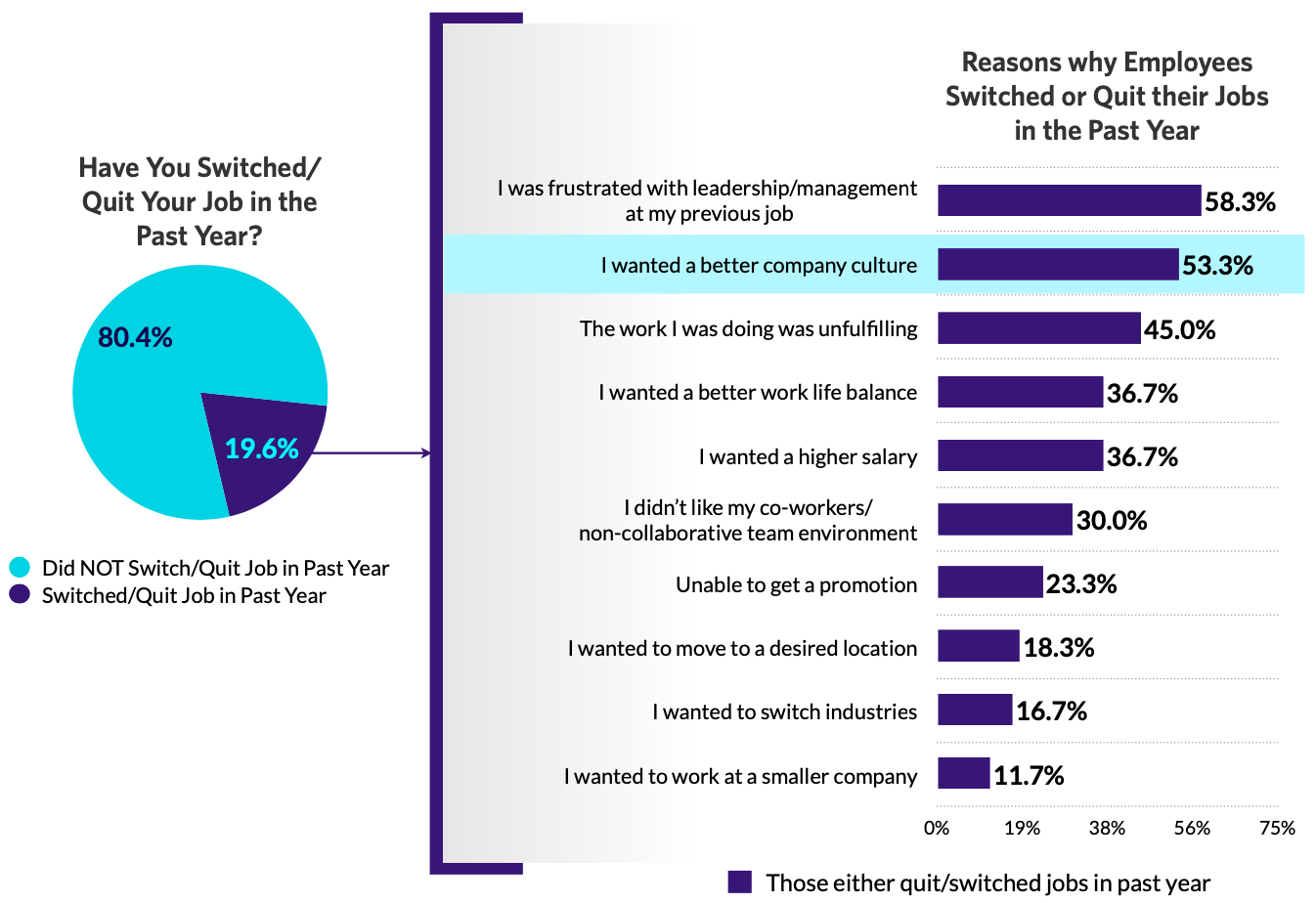
Let’s look deeper into these contrasting perspectives. As the following chart shows, there are many reasons why employees who are dissatisfied with their company culture feel that way. A number of these reasons tie back to interactions with or decisions made by senior executives, including not:
- Feeling comfortable sharing thoughts with leadership
- Receiving transparent leadership
- Getting a clear promotion path
- Obtaining adequate training
The difference in perspectives between senior executives and mid-career professionals lies at the heart of the problem of dissatisfaction with company culture. Notice what is not at the top of the list driving culture dissatisfaction: lack of salary, paid time off, or work-life balance.
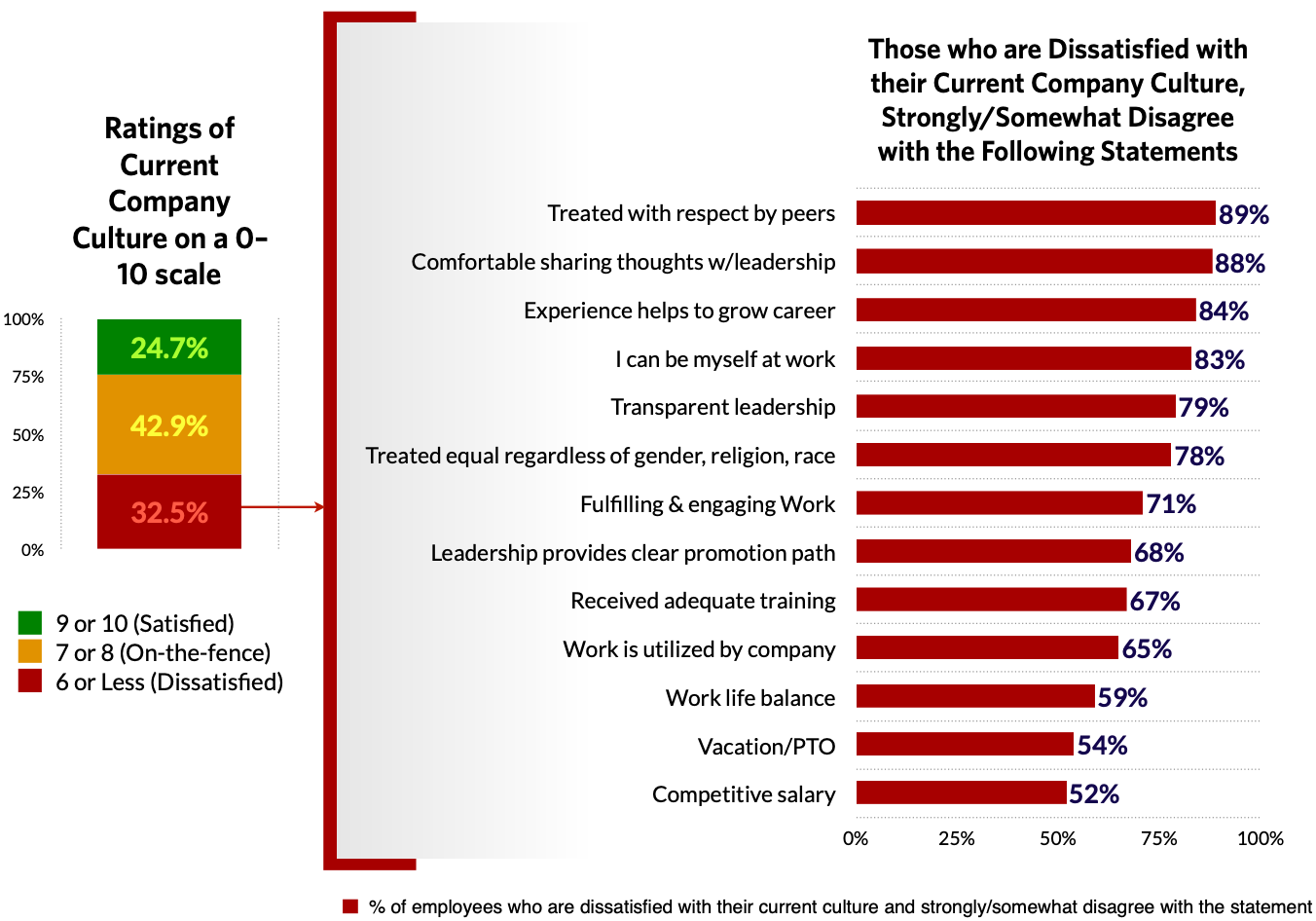
Not seeing eye to eye continues as we ask for recommendations to improve company culture. As shown in the chart below, mental health days rank highly with mid-career employees at 36.1%. Yet only 8.8% of senior executives selected mental health days as a culture improvement option. As we mentioned in our Navigating The Mid-Career Talent Crisis study, senior executives may not be aware of the stress and frustration that mid-career professionals are under.
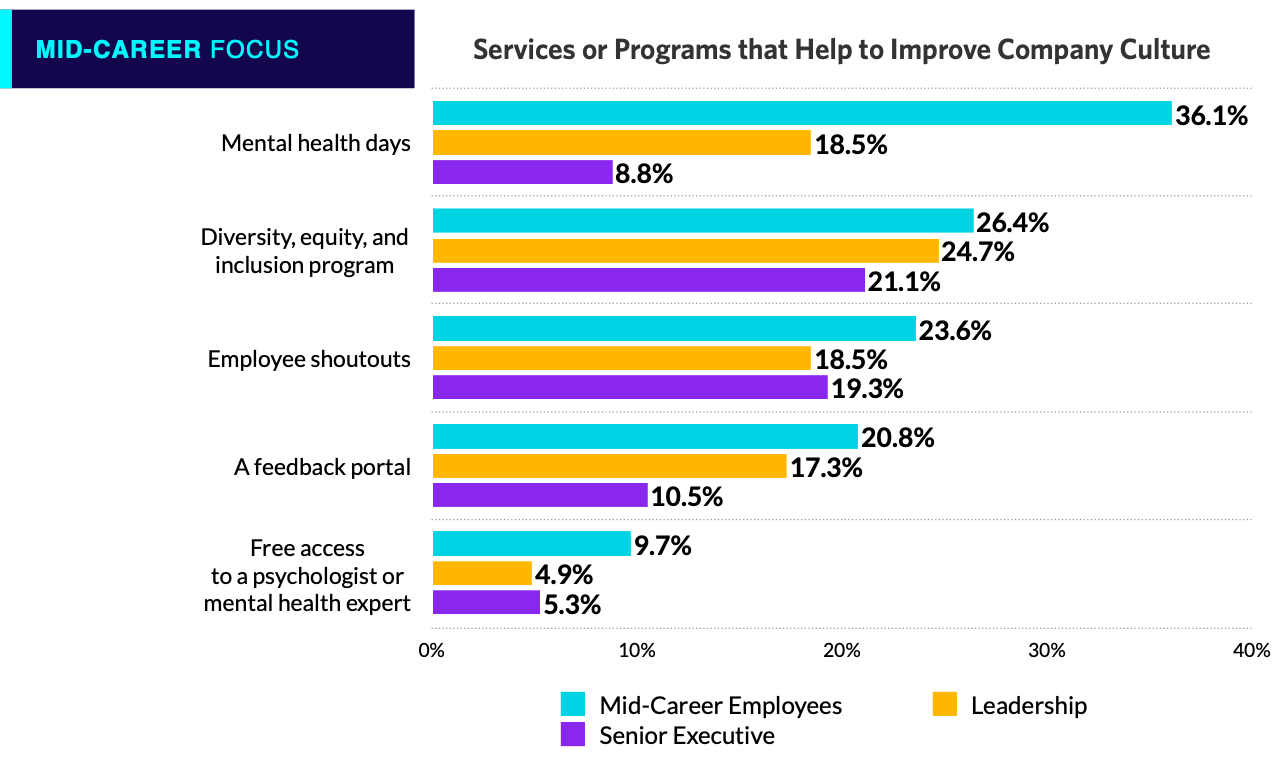
Typically, it is the mid-career staff that works with senior management to develop strategies. They then work with junior employees to executive against those strategies. The mid-career team is usually responsible for assigning work, motivating employees, and ensuring that goals are met. They are the ones that have to roll up their sleeves and get their hands dirty when necessary. At the same time they are managing remote resources, changing schedules and priorities, and more. For many, they have reached their wit’s end as they manage all of these moving pieces and make sure that they and their team stay healthy and safe.
Believing that their corporate culture does not meet their needs or that they are not getting support from their senior management team is enough to push them over the edge and either find a new job, start their own business, or take some time off to regroup.
Walk Awhile In My Shoes
For those who did not know about culture clash, hopefully your eyes have been opened and all parties can come to the table and begin discussions. Perhaps you need to start with more specific research about your organization. For those of you who knew about the culture clash and chose to ignore it because you thought the solutions were cost-prohibitive, we hope you will take this opportunity to revisit the topic. Surprisingly, many of the recommended ways to improve company culture in this research study do not cost hard dollars, they only require an investment of time and resources.
We believe that if you can get ahead of culture dissatisfaction levels before they rise too high, you have a great chance of minimizing or removing the culture clash. You will be surprised how far your organization can go if your employees feel that they are heard, respected, valued, and noticed. And employees, how do you expect your senior management to know what you are thinking if you don’t let them know. Maybe now is the time to go back to senior executives and others and try to build new lines of communication and support.
Be sure to download the CULTURE CLASH: The EMPLOYEE Experience Problem And How To FIX It study today. We not only cover talent retention issues, we provide talent acquisition findings and insights as well. You may be surprised what was ranked as the #1 service or program to improve company culture. Let the conversations begin!
Related:


